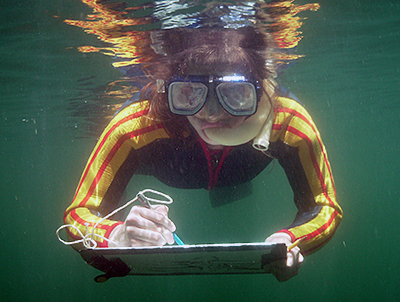
Artist Elinor Mossop Sketches the Archaeological Site While Snorkeling (Photo courtesy Steve Resler)
Project Methodology Introduction
This art/science initiative is modeled upon an Antarctica art/science collaboration by Dr. Bowser and New Zealand artist Claire Beynon. In this case, however, archaeological drawings of "The Sunken Fleet of 1758" shipwrecks and a submerged colonial wharf were scanned, assembled into quilt design mosaics, and then reduced to a miniature scale. The reduced mosaics were transformed into 3-dimensional substrates. Testate amoebae were released onto these 3-D surfaces and allowed to interact with the archaeological mosaics depicting images of sunken bateaux, a submerged colonial wharf, and other illustrations. Dr. Bowser and science artist Elinor Mossop examined this interaction using a sophisticated scanning electron microscope. Ms. Mossop interpreted the creatures' exploratory movements and created a series of cutting edge drawings and paintings that show the micro fauna encountering and coming to occupy "The Sunken Fleet of 1758."
The image above shows artist Elinor Mossop in a wet suit making sketches of the 1758 colonial dock, a shallow water military wharf constructed by British and provincial forces in the autumn of 1758. The waterfront structure allowed the British forces to dock larger warships at the military wharf to help control the waters of Lake George. This also helped the British push out of Lake George and north into the heart of French-controlled Lake Champlain, a 110 mi. long waterway that was a route to New France (Canada).
Next


